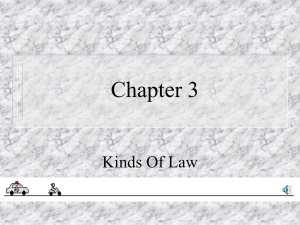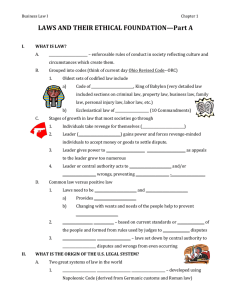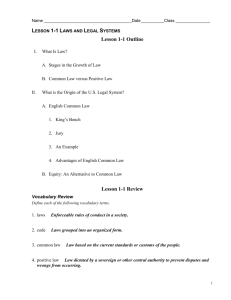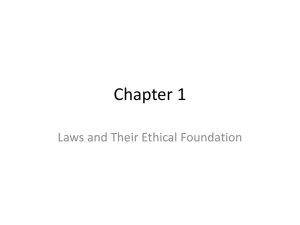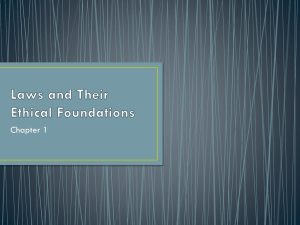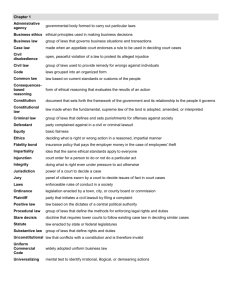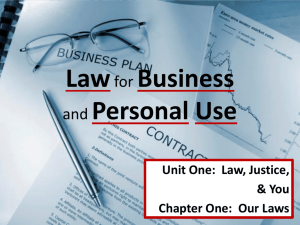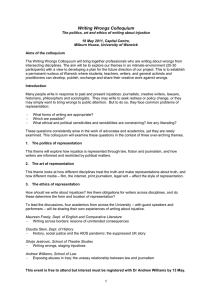NAME:
advertisement
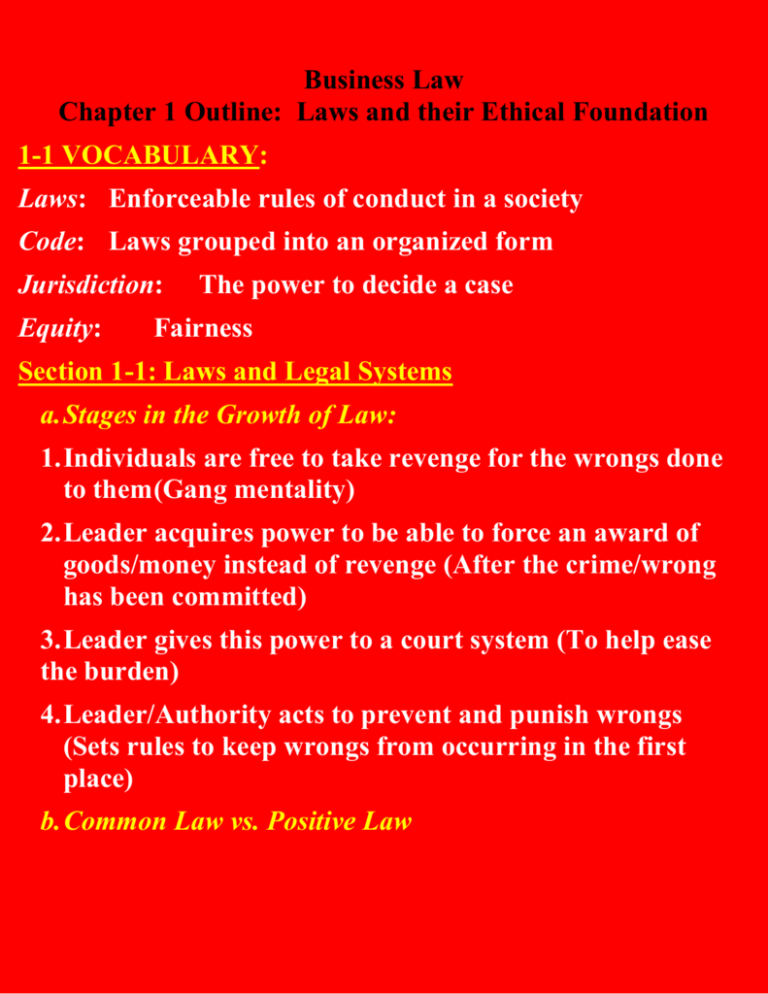
Business Law Chapter 1 Outline: Laws and their Ethical Foundation 1-1 VOCABULARY: Laws: Enforceable rules of conduct in a society Code: Laws grouped into an organized form Jurisdiction: Equity: The power to decide a case Fairness Section 1-1: Laws and Legal Systems a. Stages in the Growth of Law: 1. Individuals are free to take revenge for the wrongs done to them(Gang mentality) 2. Leader acquires power to be able to force an award of goods/money instead of revenge (After the crime/wrong has been committed) 3. Leader gives this power to a court system (To help ease the burden) 4. Leader/Authority acts to prevent and punish wrongs (Sets rules to keep wrongs from occurring in the first place) b. Common Law vs. Positive Law Common law is law based on the current standards or customs of the people. Usually formed by rules used by judges to settle people’s disputes. Positive law is law passed down from a central authority to prevent wrongs from occurring in the first place. c. English Common Law 1. King’s Bench: King Henry II in 1150 gave power to a group to judges and render $ verdicts in disputes. Would go into the country and hold “court” in various villages. They heard the most important cases. In “bad weather” they would hear appeals in London of earlier cases. 2. Jury: King Henry came up with this EXAMPLE: See Page 7 about 3. Advantages: Uniform set of law developed across the country. Allowed for changes as interpreted by the courts to reflect the changes in society. Precedent: Using prior cases as a guide for deciding similar, new cases d. Equity: An Alternative to Common Law No jury, only a judge to rule. Could grant “injunction” to prevent something from happening. You could now give orders instead of only granting remedies. Section 1-2: Types of Laws 1-2 VOCABULARY: Constitution: Document that sets forth the framework of a govt. and its relationship to its people Statutes: Laws enacted by legislatures Ordinance:Legislation enacted at the local level Case law: Law made after a trial has ended and one of the parties has appealed the result to a higher court Stare Decisis: Legal doctrine that REQUIRES lower courts to follow established case law in deciding similar cases Administrative Agencies: Govt. bodies created by federal, state, and local legislatures to carry out particular laws Civil Law: Group of laws that make up for wrongs against individual persons Criminal Law: Laws governing the citizens’ right to live in peace Substantive Law: Laws defining rights and duties of conduct except those involved in enforcement a. Sources of Law 1. Constitutions: Highest source of law. Federal constitution rules state constitutions. These are concerned with defining and allocating powers in society. 2. Statutes: Laws created by Federal and State governments. These have power over local ordinances which are only effective within the local government boundaries. 3. Case Law: Created by judicial branches (courts) of governments. Made after appeals are heard and are basis for Stare Decisis. Stare Decisis does not bind Supreme Courts. 4. Administrative Law: Laws carried out by governmental agencies, like the IRS or Social Security Administration, Division of Unemployment, etc. Usually have power to create rules and regulations and hold specific, relevant hearings. b.When Laws Conflict: Generally supremacy (higher power) rules when there is conflict. 1. Constitutions and Validity: No law can conflict with U.S. Constitution. Supreme Court determines if it does. People can overturn ruling by passing an amendment. Same concept works on state level with State Supreme Courts. 2. Statutes and Validity: Must follow Federal and State constitutions or will be overturned. 3. Administrative Regulations and Validity: Can be reviewed and overturned if they are determined to be outside of “scope” of the agency that created it. 4. Case Law and Validity: If invalid, the agency that passed the law can re-write it. c. Main Types of Laws 1. Civil and Criminal Laws: Civil laws allow individual to seek remedies for wrongs done to them, usually is $. No jail time!!! Civil wrongs are usually called “torts”. Crime is an offense against society. Government enforces criminal laws and can fine, imprison, or execute violators. A crime can be both civil and criminal and two different trials can be heard. (OJ Case) 2. Procedural and Substantive Laws Procedural law tells how rights and responsibilities can be legally exercised and enforced through legal system. They determine what remedies are available. Substantive laws define rights and duties and is concerned with all rules of conduct. They define offenses, such as murder and theft. 3. Business Law and the Uniform Commercial Code Business Law covers rules that apply to business situations and transactions and is mainly concerned with civil law and contracts. Uniform Commercial Code (UCC) governs the sale of goods. Section 1-3: Ethical Bases for Laws 1-3 VOCABULARY: Impartiality: The idea that the same ethical standards are applied to everyone. Universalizing: Test to determine wrong and right by picturing what would happen if everyone did this action. Ethics: The practice of deciding what is right or wrong in a reasoned, impartial manner. Civil Disobedience: Open, peaceful violation of a law to protest its alleged or supposed injustice. Integrity: Capacity to do what is right in the face of temptation or pressure to do otherwise a. Basic Forms of Ethical Reasoning 1. Consequences-based Reasoning Looks at alternative ways to alter the situation and forecasts the consequences of each. Then, select the alternative that creates the greatest good. 2. Rule-based Reasoning Acts themselves are judged as right or wrong, either based on authority or human reasoning. Authority is often religious. b.Ethics Reflected in Laws: Since U.S. uses a “majority rules” government, most of its laws reflect consequence based reasoning. However, the Bill of Rights and other laws (such as those protecting minority interests) do reflect “human reasoning”. 1. Fidelity Bond: An insurance policy that pays the employer money in the case of theft by an employee. 2. Scofflaws: Person who does not respect the law, but assess the risk of being caught and punished against the benefit to be gained. Never can ethically justify breaking the law. 3. 5 factors determining Civil Disobedience a. Written law is in conflict with ethical reasoning. b. Effective political means are not available to change law. c. Civil disobedience is nonviolent d. Civil disobedience does not advance a person’s immediate self-interest (personal gain) e. Is public and one willingly accepts the punishment for violating the law
